It’s been a while since I last provided an update on my ongoing attempt to expand my home theater beyond the conventional channel limits allowed by Dolby Atmos or DTS:X. Never satisfied, I’ve now crammed 17 speakers into my room. If you can believe it, in some ways this has actually simplified matters since my last attempt. Of course, in other ways it’s even more ridiculous.
I started this grand folly almost two-and-a-half years ago, when my receiver at the time maxed out at the typical Dolby Atmos limit of 11 channels, in a 7.1.4 configuration. Wanting to extend that to six height channels, I implemented a convoluted system involving two additional A/V receivers to extract Top Middle channels from between the Top Fronts and Top Rears. You can read about that in previous installments of this series.
Last year, I upgraded my receiver to the flagship Denon AVR-X8500H model, which is capable of decoding 7.1.6 channels all on its own. In theory, this should have solved all my problems, allowing me to get rid of all that excess equipment and streamline everything into one processor. For me, though, it’s never so simple. Whenever I have things right where I thought I wanted them, I suddenly want something else. The upgrade itch is never quite scratched.
This time around, my urge to change things up was motivated by a bargain I scored on a set of four new speakers to replace my prior Surround and Surround Back sets. I wasn’t so bothered by pulling the old Surround Backs out of service, but my Surrounds at the time were actually pretty nice speakers that tonally matched my front towers, and which I had only recently acquired not long before. I just hated the idea of sticking them into storage or selling them off. I wanted to find a way to make use of them, and I thought that perhaps this was finally the time to experiment with Front Wide speakers.
I considered this idea a few months ago, but discarded it as not feasible with my receiver. For all of its processing power, the Denon X8500H is limited to 13 channels of decoding, at either 7.1.6 or 9.1.4. The former means I couldn’t use Front Wides, and the latter means I’d have to give up a pair of height speakers. I wasn’t willing to do that at the time.
However, the idea kept gnawing at me, and I still have those extra A/V receivers. If I configured for 9.1.4 and then extracted Top Middles via the “Scatmos” method I’d used earlier, that should work, right? Well, almost…
Complications
What I’ve just described would in fact work when playing a Dolby Atmos soundtrack, but would not work when watching 5.1, 7.1, or other legacy soundtrack formats upmixed using the Dolby Surround Upmixer feature in the receiver, which never utilizes Front Wide channels. Those speakers would be silent, and since actual Atmos only accounts for a small minority of the content I watch, that seemed fruitless.
Fortunately, the DTS Neural:X upmixer will utilize Front Wide channels. That’s an advantage in DTS’ favor and seems like an easy solution. Sadly, both Neural:X and the DTS:X formats are currently hard-locked to an 11-channel limit. If you turn on Front Wide speakers, you’re forced to give up either the Surround Back channels or one pair of the height channels. The only workable options are either 5.1.4(+W) or 7.1.2(+W).
I’m not ready to give up Surround Backs. First off, I just bought new speakers to put there. Moreover, removing those would leave a huge auditory hole in the back of my room. That’s not happening.
I’ve gone over every possible permutation of this, and what I’m left with is needing to manually switch between two separate configurations. When listening to a genuine Dolby Atmos soundtrack, I can enable all 7.1.4(+W) speakers. But for anything else, I have to scale down to 7.1.2(+W) and use Neural:X for upmixing. With only one pair of active height channels, that means Top Middle extraction won’t work.
The Compromise
Here’s a look at my room layout:
And here it is with the speakers labeled:
That’s a lot of speakers. Getting them all to work at the same time is tricky and requires some compromises.
For a long time, I’ve been stuck on the idea that the only way to properly do six height channels in Atmos is with discrete Top Front, Top Middle, and Top Rear speakers. Indeed, that may be the ideal. Giving this some hard thought, however, I’ve come to the conclusion that, in my room, the speakers I was calling “Top Rear” (but which actually more closely align with a Rear Height position) are very far behind my seats and hardly ever noticeable in movie content. Both the Front Height/Top Front and the Top Middle channels are much more important in this space and deserve to be prioritized. In fact, activating the Top Rears draws a lot of sounds away from the Top Middle speakers, thinning out the soundstage above my head.
This doesn’t mean that I’ve decided to abandon the Top Rear/Rear Height speakers that are already installed on my ceiling, just to de-prioritize them. They’ll still produce some sound, but mostly just ambient and atmospheric effects to fill the space, not as many critical sound effects.
How do I do that? I’ve put one (just one) of my spare A/V receivers back into service. In my primary X8500H receiver, I configure for 9.1.4 speakers, with Front Height and Top Middle designations. The signal for my Top Middle speakers is sent through that receiver’s pre-outs into the stereo inputs on the secondary receiver, which uses ProLogic II to extract a common center that gets spread to my two Voice-of-God speakers in an array, and then pulls some diffuse sounds to its “Surround” channels (my Rear Height speakers).
This is actually very similar to a process I used a long time ago, before I went full Scatmos, but I’ve learned a lot since then about how to do the extraction properly, so it should work better now, especially since I’m in a mental headspace that the Rear Height speakers are just an add-on bonus and not a critical part of the soundstage.
Upmixing and DTS:X
As mentioned, Neural:X and DTS:X are limited to just two height channels of sound once I engage the Front Wide speakers. In the X8500H’s setup menus, I manually change from this:
To this:
If I designate the two height channels as Top Middle, this allows me to continue to use the secondary AVR for the extraction to the Voice-of-God and Rear Height speakers. That just leaves the Front Heights unused… or did, until I discovered this:
In the X8500H’s Amp Assign/Settings sub-menu, I found that it’s possible to assign both the “Height 1” outputs (connected to my Front Height speakers) and “Height 2” (connected to my Top Middles) as Top Middle simultaneously, meaning that the same sound will play from both sets of channels. This may lack the front-to-back panning ability of Atmos or DTS:X when using four discrete heights, but it’s effectively the same as what the Dolby Surround Upmixer (which really only has two height channels spread across the left and right sides of the room) does. That’s not so bad. I can live with that, especially for upmixed content. And DTS:X accounts for such a tiny fraction of my Blu-ray collection that it’s hardly worth fretting about.
Frustratingly, after switching from four height channels to two, the X8500H automatically changes the pre-out assignment for the Top Middle speakers from Height 2 to Height 1 and does not allow this to be changed back. That means I need to keep two sets of cables connected, one pair to the Height 1 pre-outs and another to the Height 2 pre-outs. Those go into separate inputs on my secondary AVR, and I have to remember to change that setting also when I’m doing the rest of this.
The Result
To be sure, all this manual changing of settings is a pain in the neck, and there’s no good way to automate it. The Denon X8500H does not allow you to save two different speaker layouts as presets. The best I could do is save each configuration profile to a USB thumb drive and load them when needed, but that would take as long or longer than adjusting the settings individually, so there’s little point in it.
On the other hand, this new system layout has allowed me to streamline my hardware components, removing one of the extra A/V receivers, as well as a pair of stereo-to-mono converters and a mini-amp (both explained in Part 4 of this series), not to mention a bunch of cables. It winds up being a net wash, as far as complication goes.
Things will be a lot easier for me if Dolby ever enables use of Front Wides with the DSU upmixer or DTS breaks from its current 11-channel limit (preferably both).
Having done all this, was it worth the effort? I’d like to say so, but I’m not sure that I’ve settled on an opinion about the Front Wide speakers yet. I know that a lot of people love and swear by them, but I think perhaps I need to get used to them a little longer. The thing I notice most about them is that music typically gets spread wider across the front soundstage, which can be appealing at times but feel gimmicky at others. I don’t often notice discrete sound effects there, but panning movements from Front to Surround (such as a car driving toward the back of the room) are often impressively smooth and seamless, without a noticeable jump from speaker to speaker as I may have experienced previously. I like that.
The reduction from six discrete height channels to four (for Atmos) plus a little non-specific ambience hasn’t bothered me much so far. If anything, shifting the weight from my Rear Height speakers to Top Middle has been an improvement. For upmixed content, DSU only ever had two effective channels in the heights, so I haven’t actually lost anything there. However, aside from being able to use the Wide channels now, I’m not as much a fan of using Neural:X for upmixing as I was for DSU. Although the DTS algorithm often pulls more sound info to the height channels, I frequently find that it’s too much and boosted too loud in volume, to the point that it’s distracting. All things considered, I’d rather use DSU, if only it supported Front Wides.
For the time being, I’m going to settle in with this and do a lot more listening before I come to a final conclusion. I doubt that I’ll take away the Front Wide speakers, but I also have no doubt that I’ll want to change things up again at some point later. That’s an inevitability in my home theater.

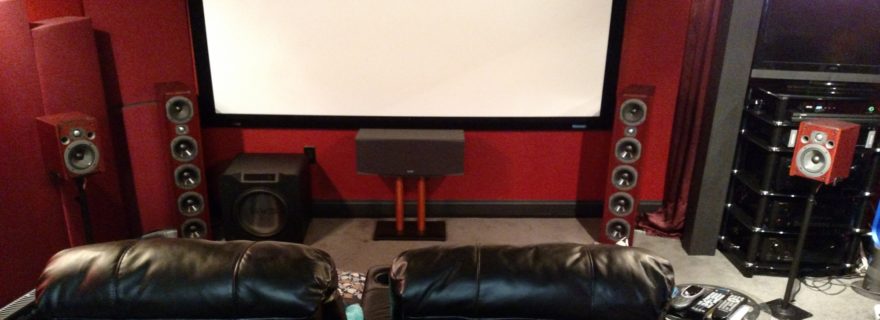
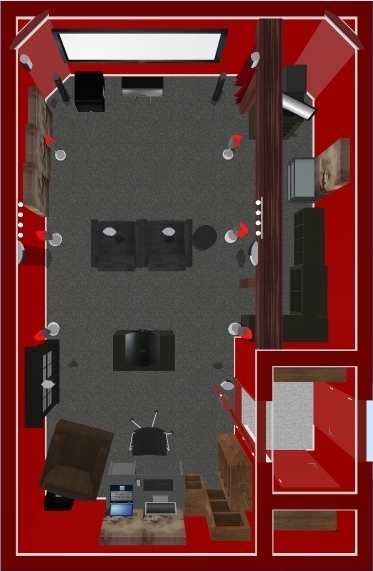
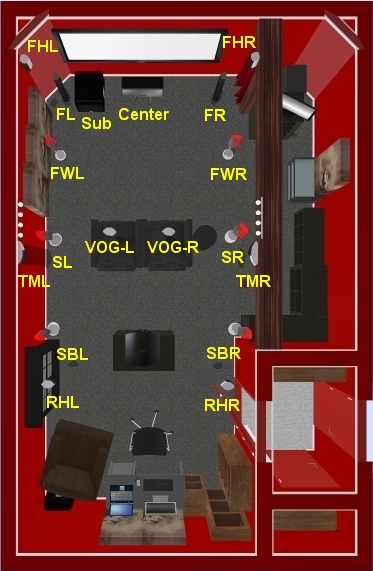
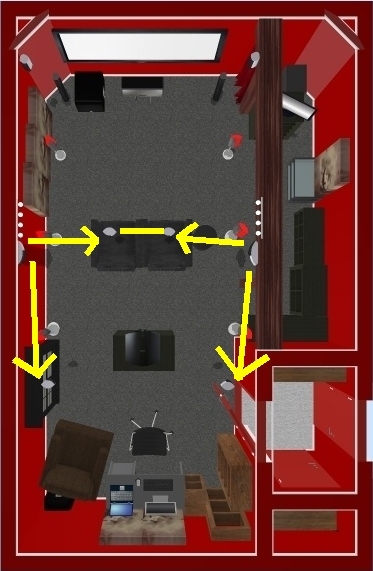

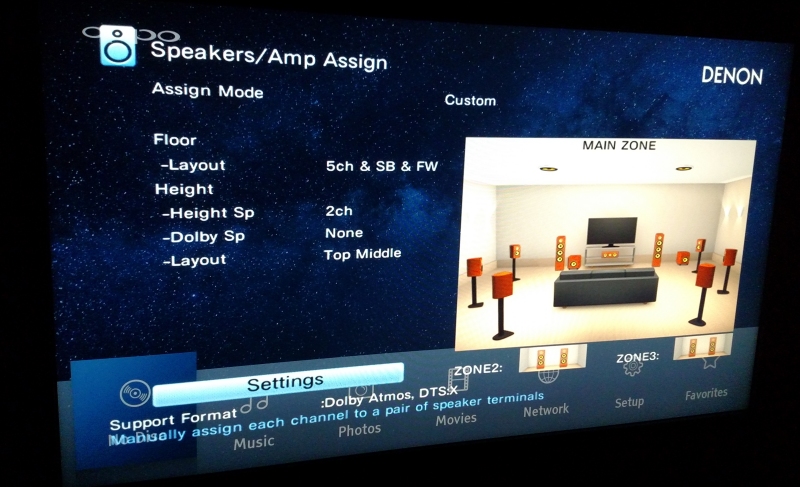
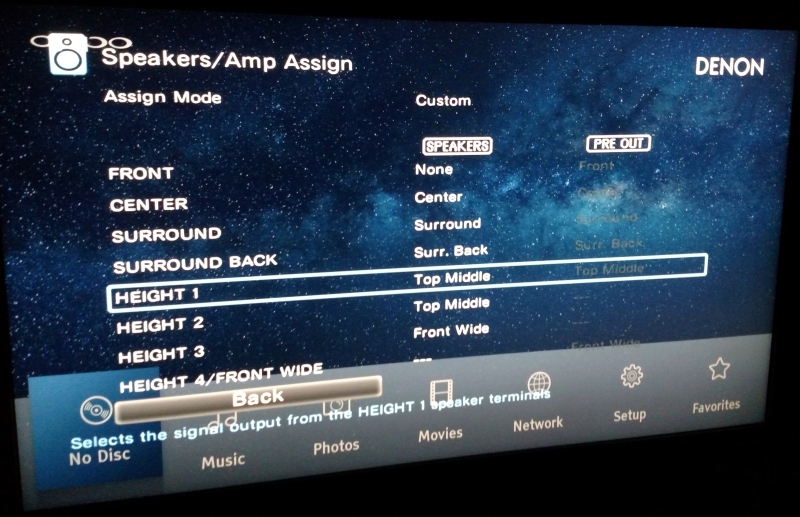


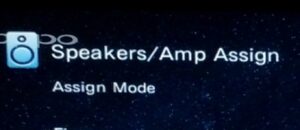
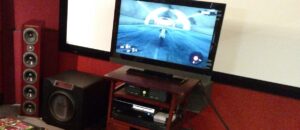
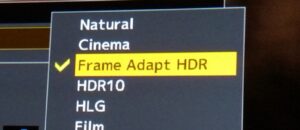
Al
I’m usually quite interested in these pieces, but this one was absurd, before I even read a word of it. One look at the picture that you posted told the whole story. I’m sorry, I just find this utterly ridiculous. Your HT room CLEARLY isn’t wide enough to even mess around with, or experiment with adding front wides. I’m incredulous that the thought of it ever even crossed your mind.
Josh Zyber
AuthorThe Front Wide speakers in this case are intended to fill the gap between the front mains and the Surrounds. Calling them “wides” is something of a misnomer, since the goal is for speakers to circle the seating position, not to spread out laterally across the front wall.
See this speaker layout image from a Denon manual and compare it against the last photo in the post. (The room design graphics in the post are not precise measurements and are compressed a little or else you wouldn’t be able to see speakers beneath the support beam.)
Al
Okay, fair enough… you’re right, and I actually understood this, before you pointed it out. The absurdity of you doing this is more about the fact that you’ve chosen to sacrifice ever having discreet Dolby Atmos, for matrixed Atmos, matrixed DTS: X, and the inconvenience of thumb drives and switching back and forth in your receiver’s menu. It all points to you sacrificing better and more pure sound, for added gimmicks, and having to deal with a lot of hassle and inconvenience, in order to make this sacrifice, to boot. It’s all just preposterous.
Josh Zyber
AuthorI fully admit that my quest to shove as many speakers as possible into this small room is ridiculous. No argument there. I’ll cop to that.
However, I disagree that the sound is somehow less pure because I use matrixing to supplement the discrete channels. The sound that gets matrixed into the Front Wide speakers and the Voice-of-God speakers is all sound that was intended to image in those locations anyway. I’ve just put physical speakers there rather than rely on phantom imaging. The Rear Heights are perhaps less “pure,” but hardly anything goes to those speakers except some ambiance bleed anyway, so they’re hardly a factor. I only keep them engaged so that the back half of my room doesn’t awkwardly fall off into silence. (Also, they’re already installed in the ceiling, so it would be weird to leave them hanging there unused.)
Al
Whether or not the sound was intended to reach specific locations or not, the fact that the sound is being matrixed to those locations is the very definition of less pure. It’s no longer in its lossless form, as authored in the audio mix. Otherwise, we could argue that applying DSU to a 5.1 DTS track doesn’t make any of the sound coming from any of the locations less pure or different than if you were listening to a Dolby Atmos track. Matrixed is matrixed, regardless of whether the sound is intended to image to a designated location or not.
Josh Zyber
AuthorThe sound is still lossless. It’s just deriving a common center from between two channels based on audio cues that are identical to both and anchoring that into a physical speaker.
Anyway, are you arguing that you should never use upmixing either?
Al
I’m arguing that upmixing doesn’t deliver the same experience as the native audio track, due to… you guessed it… matrixing.
Josh Zyber
AuthorSure, the native track will have big gaps between speakers and total emptiness above you. 🙂
Al
I take it that means when you pop in a disc that contains both a Dolby Atmos track, and a 5.1 track, you choose the 5.1 track and listen to the DSU upmixed version of it. 😉
Josh Zyber
AuthorGiven that Atmos will use all of my speakers (including Front Wides), that doesn’t seem very logical.
Al
I agree. And yet, you’ve chosen a matrixed version of it, only to add additional front speakers to a small listening area. 🙂
Josh Zyber
AuthorWhen playing a native Atmos track, the Front Wides are fully original and discrete, no matrixing. I only use Neural:X when upmixing legacy sound formats.
Al
Yes, the front wides are. The rest of the speakers? Well, that’s a different story.
Josh Zyber
Author“Purity” is much more important in the ground-level soundstage than the heights.
Al
I like how that word was placed in quotations. It’s as if you’ve never argued for native over matrixed before. Hmmm… how many blog posts could we pull up where you argue for native? What about some of the old columns that you no longer write? How many of those could we look at, where you argue that matrixed is inferior?
Josh Zyber
AuthorNative discrete to all speakers would be better, but if that’s not available, you do what you can.
Here’s my question to you: When you watch a movie with a 2.0 stereo/surround soundtrack, do you listen to it in “Direct” mode only from two speakers, or do you use ProLogic/DSU to derive a center channel and surrounds?
Al
I’ll admit to using Neural: X and DSU for modern audio tracks that are natively 5.1 or 7.1, every time. I think the sound design of many of those tracks lends itself well to upmixing. However, when it comes to whether or not to matrix a stereo/mono track into surround, that depends on the actual film, along with it’s age, genre, and how well the original stereo/mono track has been restored and authored. If listening to the original track suits the film better, and the studio has done an excellent job with it, I would choose the original audio. If matrixing into surround suits the film better, and the studio hasn’t done a particularly great job with the original audio mix, I’ll use DSU/Neural: X. How about you? What do you typically do with a stereo or mono track?
Josh Zyber
AuthorMost 2.0 tracks are actually Dolby Surround mixes with matrixing cues embedded into them, and are intended to be decoded into surround sound. The upmixers don’t really do much with mono soundtracks, except redirect tracks authored as 2.0 mono into the center channel.
In most cases, I just leave DSU (or now Neural:X) on by default.
Al
I’ll be more specific. Let’s say it’s a classic old Hollywood film, or a foreign Criterion high-art film, and the track is a DTS-HD 2.0 track, not a Dolby surround mix. I’m listening to the original audio mix. What are you doing?
Josh Zyber
AuthorMost of those are going to be 2.0 mono, with very rare exceptions for 2.0 stereo with no surround. In either case, I’d want dialogue reproduction to come from my center speaker, not the sides, so I’d turn on DSU/Neural:X.
In most cases, these upmixers do the right thing with vintage soundtracks and leave them in the front soundstage.
William Henley
While I love reading these blogs, and would love to have a wall of sound myself, I think the issue I would have with even considering this is if the payout is worth the cost and the frustration. Like if something is Dolby ProLogic, it sounds okay matrixed to 5.1. Not as good as discrete, but its still better than the 2.0 that I would have otherwise. That is fine, it is made to do that. But if I try to matrix it up to 7.1, suddenly things sound awful – it is like the sound being extracted to the back 4 speakers suddenly lost a lot of dynamic range and resolution – like digitized sound samples coming out of a Sega Genesis or Super Nintendo. It is even worse if the track is 2.0 without the ProLogic encoding. Now granted, things sound much better if I take Dolby TrueHD or DTS MAster Audio or PCM 2, 3, 4 or 5 channel and try to matrix it to 7, but as I am not exactly sure what is causing the horrible sound issues with lossey or analogue audio, i would not want to drop the money to try it.
But what is worse is, even if I could resolve the sound quality issue, my issue is if it would really be that noticable with the extra speakers. I mean, I can go into an Atmos auditorium where they may have over 40 discrete channels of audio. They play that Atmos demo before the movie, and it sounds great – you can certainly hear things pan around the auditorium. Then the movie starts. and while there may be some sounds that come from overhead or some random side speaker, for the most part, I don’t perceive a huge difference, and I think I would have to do an A to be comparison to notice. Shoot, even at home, there have been times when my sides or rears stop working (usually due to weak connection – I never have gotten around to running my wires through the walls) and I may not even notice it for weeks. Shoot, when I moved into this house, I went over two months before I realized I had never powered on the sub, and it was only when I put in Lord of the Rings that I thought “did I not calibrate my system right? I am pretty sure this movie has more bass than this!”
So yeah, while I am sure your system is significantly better sounding than mine, I would need to hear an A to B comparison, and if I were blindfolded and not told which were which, I am not sure if I could on a good deal of content. I am sure there is some that it sounds great on, but you have got to be getting more and more dimenishing returns with each upgrade. I mean, thinking of all the speakers, subs, amps, wiring, you have got to be sitting well over $10k in audio alone, and I have to ask if there is really a huge difference in sound over someone that spends 5 grand on audio, or I will even go as far as to ask is it really all that much better than a two or three grand system? I mean, granted, yes, it is probably is better, but is it worth the cost, and can you tell the difference in a blind test? Not even an A / B test, just have someone blindfold you, stick in a random movie, have them select whether its discrete Atmos or matrixed to all your speakers, but only play it one way – you get one chance to guess whether the extra speakers or on or not. Could you tell the difference? And if you have trained yourself to actually pick out the difference, does it bother you if you go to a theater and something playing is only in 5.1?
I hope I am getting the point across. I mean, its a neat experiment, and yeah, it probably does sound better, but I wonder if one day, you are going to look at the time and money spent, and think, “Wow, I could have used that money to take the family to Disney World and gotten out of the cold for a couple of weeks!”
SO yeah, I am not siding with AI – I am with Josh on the classic Hollywood movie, I want my 2.0 upmixed to 3.1 (and depending on the content, 5.1 is okay if you are filling the soundstage with music or something – take Singing In the Rain, lets have singing in the front center, and the music and rain fill the sound stage. I am okay with that. I have no issue with the concept of matrixing sound. I am not a purist. I watch colorized movies, 3D conversions, and I will take 480i content and deinterlace, upconvert and sharpen them to make them look better. I have taken some movies and ripped the discs and run them through some filters in Premiere to clean up grain (only if it looks REALLY bad like it seems like the source is a couple of generations away from the master and I seriously doubt there is that much grain in the original film stock, and the grain and noise just looks awful), some sharpening if the image looks soft (the main movies I have done these on is classic live action Disney movies that only get released to DMC members – it is like Disney has no love for these movies and slapped an old transfer on a disc). I have no issue with enhancing the movie viewing experience. But there comes a point where we have to say “Dude, you have an addiction, and this is an intervention!”
Al
I think William may have expressed my incredulity better than I did. My main point, all along, is that spending extra money, dealing with hassle and inconvenience, having to switch settings back and forth, saving on thumb drives, and even going so far as to sacrifice native, discrete Dolby Atmos, only to add a few more front speakers to a very small listening area is just absurd. I’m okay with the overall cost — I run a Atmos/DTS: X 7.2.6 system — but there’s just no way that doing this made Josh’s setup sound better. It’s simply not possible. It may have made it sound marginally DIFFERENT, but certainly not better. And dealing with such a hassle, putting up with such inconvenience, and sacrificing native discrete is not something that makes any sense, unless it delivers a HUGE improvement.
I agree with William. If you blindfolded Josh, and placed him in this listening area, in the middle of any given random scene from different films, the success rate of him accurately guessing which settings were adjusted to switch which speakers were being used back-and-forth would be extremely low. He might accurately guess 30%-35% of the time, at most.
William Henley
I think we are almost in agreement. Matrixing to me is not necissarially a bad thing if its done well. I will matrix a 5.1 up to 7.1, or a 2.0 up. But in those, setups, I don’t think you are giving up the discreet, I think rather you are just adding something to other speakers. You know, now I am wondering about that – if I have the audience clapping behind me when watching a talent show in television, is it copying that sound out of another channel or is it pulling it out of another channel, meaning all channels are now processed. Hmmm… In any case, I guess I am back to the argument about if it is done well.
My argument is more along these lines: two people are sleepy and need caffine. You have the choice between a English Breakfast Tea and a Red Bull. I think most people would argue that the sugar and the caffine and the Vitamin B and the Turin in Red Bull are going to make you feel much better than the tea will. My issue is that Josh is on his third can of Monster – and the metaphore actually seems to work better for your point than mine – I think we can agree that a single 16 ounce Monster is going to give you more energy than an 8.4 ounce Red Bull. You add that second can, and… eh, you don’t really get double the energy of a single can, and after a while, you start to feel worse. It seems as if Josh is the kid who instead of saying “maybe I had too much” decides to have the third Monster to get that buzz again.
I am like the kid with the Mountain Dew. “I paid $1.25 for for a 20 ounce! Its good enough, I feel great!” Most of my friends are drinking the horrible coffee out of the breakroom. A normal home theater is the kid with the Red Bull. You are the kid with the Monster, Josh is the kid with 3 Monsters
Josh Zyber
AuthorYou two are awfully judgy this week.
EM
All those beverages are awful. Iʼll take Tang—it got the astronauts to the Moon—if not actual orange juice.
Al
Ahhh… that makes a lot of sense. Clever analogy. Thanks for following up on that.
Chuck
Nice write up and experiment. I was constantly fussing and experimenting with Audyssey over the years especially Atmos placement. Tried mounting satellites on my ceiling as well as 2 different modules. Niether sounded right to me. I have come to the conclusion that I do not like room correction across the full spectrum. I was using the Audyssey Flat curve with Dynamic EQ engaged. Combined, they made Atmos tracks too bloated and far less natural sounding. I get far better results using the MultiEQ Editor App. I use Klipsch RP140sa modules and when I limit MultiEQ frequency to 300-500hz Atmos mixes really come alive sounding more convincing. Before I just hear noises above my head, it sounded muddy. Audyssey either dulls the sound with the Reference curve or Flat makes my speakers sound unnaturally clinical. Also, turning off DEQ is the best thing I could have done in my room after limiting MultiEQ. Bass sounds more natural, blending better in my room but the real winner is how much clearer my speakers are without all the added crap and EQ. The detail is startling better. If you have the 8500 I would try calibrating using the app and limit the frequency as well. Your room looks well treated so I am confident you will hear the benefits. One size fits all EQ can do more harm than good. That was the case in my room.
Josh Zyber
AuthorHave you measured your frequency response with Room EQ Wizard? In my room, there’s no question that I get flatter results with Audyssey than without.
That said, be aware that Audyssey’s MultEQ Editor App rolls off bass below 20Hz, while Audyssey calibration in the receiver will not do that.
Chuck
I’m aware of the rolloff but D&M have stated that will be fixed in either the next update or the next. When I calibrate through my Denon my subs are too low. They are set at -8.5 so I had no choice but to use DEQ because bass was non existent without it. When I calibrate using the app bass is much tighter and cleaner and my dual SVS’ are set significantly higher at -4.5. My RP’s are pretty flat in my room to begin with, using MultiEQ below 300hz is really where they need the help. Finally now with the app Audyssey is approaching Dirac. The benefits of Audyssey are clearer in problematic rooms but I have a dedicated room that’s treated and room correction doesn’t do it any favours. Of course every room and speakers are different as well as personal taste but it’s nice that Audyssey is now customizable.
Josh Zyber
AuthorIt seems to be a known issue that Audyssey will set the subwoofer channel 3dB too low. You can confirm that with test tones after a calibration. It’s been that way forever. I think Audyssey has a rationale for why they do that, but it doesn’t make much sense to me. Simply increasing the gain to that channel by 3dB seems to take care of it without need for DEQ.
Chuck
Yeah Audyssey has always done that, glad the app fixed that. Most other room EQ’s seem to boost bass since people prefer that over a Flat bass. Once they get rid of the dip the app will be perfect.
Josh Zyber
AuthorThe thing is, the default Audyssey setting for the subwoofer channel is not flat. It’s measurably too low. Only by raising it 3dB does that channel calibrate to the same standard as all the rest. So, it’s not even about personal preference. It’s about Audyssey being consistently wrong.
Fortunately, because it is a very consistent error, it’s easy to correct by raising that channel 3dB after calibration.
Chuck
I suppose D&M are aware of the issue now that the SW level is set properly using the app. They just need to fix the dip lol.
Anyway, I found it odd what room correction did to Atmos in my room. I’m done tweaking until I add another pair of speakers.
Derek
Josh thanks for the great write up. I’m surprised by some of the feedback. The home theater hobby has always been about experimentation, seeking to satisfy personal preferences and enjoying the upgrades and tweaks. It’s why we love it. It’s why we talk about it. My home theater is unique. Josh’s is unique. It’s about the freedom of choices we can make (components, sources, display technologies, surround formats, room correction/EQ, speaker location etc which are often filtered by $$$, space and WAF). It’s always a work in progress. Went from CRT to overhead CRT to DLP projection from ProLogic to DD to DTS to Surround EX to discrete 5/7.1 to Atmos/DTS:X. Building, upgrading and experimenting is half the fun…and if it looks and sounds better..to me…it’s a winner.
Al
We experiment in order to get better results plus added convenience. Experimenting in order to sacrifice better sound for additional hassle and inconvenience doesn’t make any sense. It’s not what this hobby is about.
Josh Zyber
AuthorI’ll be the judge of whether the sound is better or not better. Having actually listened to this, I’m in a better place to know than someone who has not.
Al
Placebo is a strong and real thing, isn’t it?
Josh Zyber
AuthorI don’t know why you’re being so argumentative. If this isn’t something you want to try in your own home theater, nobody’s forcing you.
Al
I don’t see it as argumentative. Read your last two paragraphs again.
You actually come right out and say that you don’t know if it sounds any better, and you’re not entirely sold on it. You also admit to the hassle and inconvenience. I just find it interesting that after acknowledging that it didn’t sound better in your column, you decided to act like it is a revelation, in the comments section. Like I said upfront, to me, it’s just absurd to go to all of this trouble and sacrifice discrete for something that you acknowledge is merely different, but not necessarily better. I don’t mean that as argumentative; only as one person’s opinion.
I’m more interested in your columns that are actually about improvements and upgrades, rather than dealing with a pain in the ass in order to get nothing more than different. That’s all.
Chuck
To be fair it’s an experiment so I don’t know why you’re getting bent out of shape. Would most people attempt the experiment? No. But most are set it and forget it types. HT enthusiasts are always tweaking, I know I do until I find what I like.
MagnumX
There’s nothing wrong with “matrixed” sound. There’s two types, extracted “near discrete” and “additive” (with an active mixer). The latter is great for getting “array” style duplication to more than one row of seating while providing smoother pans for the MLP. It hurts exactly NOTHING (I can easily turn it on/off to compare here and I’m doing 11.1.6 with extracted top middle and matrixed front and rear wides with three rows of seating in a 12×24 room). The matrixed spekers give an array effect for multiple rows of seating and increase depth and even cancel some side reflections from the front wides for stereo material (you can clearly hear the sharper/cleaner/more depth image when turning them on versus off to compare). I also do dialog “lift” using an active mixer putting L/C/R into the heights in addition to the actual heights (all mixed to create a dialog level even with the middle of the screen).
But this idea of “pure discrete” misses the point entirely. 7.1.4 is simply insufficient with multiple rows of seating and companies like Disney are creating problems with higher-level AVRs that CAN do discrete past that point. By using extraction/matrixing, I get around the DTS 11-channel limit and Disney’s BS “print” Atmos mixes. I guarantee you they sound better in my room than 7.1.4 would any day of the week. The spread between front and back is too far to not use a top middle set of speakers. One row of side surrounds is insufficient for three rows of seating. It needs at the very least an array copy of the side surround for the next row, but that would image in-between the two sets of speakers. By matrixing an extra set between side surround rear surround, you get a full spread and true panning with Atmos/X while getting an array effect with 5.1/7.1 upmixed material for those rows. A true discrete high-end Atmos setup would leave those speakers UNUSED (either due to DSU doing nothing with many of them or DTS/Neural X hitting its crappy 11-channel limit). You’d get neither matrixed or discrete output. You get NOTHING.
Dolby used arrays and matrixed effects for decades to make multi-row theaters work. Older soundtracks still need love and attention and 5.1 doesn’t cut it with three rows of seating without some upmixing and either array/matrixed or extracted sounds to spread the surround across the room for all seats to have good quality sound.
I see no point in the VOG speakers as Top Middle will phantom them anyway. I use a second row of side surrounds in my “17.1” channel home theater between the second and third row. I have a switchbox to do side height true Auro-3D as well (I have over 10 native titles plus music). I’ve been thinking of adding another 11-channel AVR to do four “Top” speakers as well (currently using front and rear heights plus top middle). These would be front/rear tops, giving me up to 10 overhead speakers. Any overlap would array between height and tops, but provide much further reach from the screen edge to the back of the room for all three rows of seating. A single 17-channel receiver would still have the 11-channel DTS limit and problems with “printed” 7.1.4 Atmos tracks like Disney is using. I get around all these problems and it sounds fantastic. You can see my system on AVS under the same name.
dawei
finally you got X8500H, atmos has 11.1.8 comes out already.
we need 19.1 receiver
https://www.dolby.com/us/en/guide/speaker-setup-guides/11.1.8-mounted-overhead-speakers-setup-guide.html
Josh Zyber
AuthorThe X8500H can only process 13 channels at a time: either 7.1.6 or 9.1.4.
dawei
We need something new such as Emotiva RMC-1 =>$5K Modular Expansion Options($700 ea), Upgradable FW/SW, <= 15.1.8 Atmos support limit. FRU Video input module up to HDMI 2.1
MagnumX
That’s actually pretty close to my 11.1.6 layout I have here except I use an Extracted Top Middle (in the Auro-3D surround height location) + Front and Rear Height instead of Top Front/Rear + Front and Rear Height. I use Matrixed front wides and Surround #2 (‘rear wides’) as I’d need at least 17.1 to do it discrete. I’ve thought about adding Tops and using the Surround Heights only for Auro-3D, though. I can’t make use of TS (VOG) because of a steel beam box that would block it for half the room). But that’s the sort of setup I’d need to go full discrete. I could almost get there using two receivers, but I’d have to turn Neural X off for DTS:X to avoid leakage in channels I don’t need with dual receivers. It’s really too bad they didn’t have a “handshake” mode to use dual receivers combined (so the renderers know not to make up for channels the other one is using), but then I suppose that would greatly cut into their profit margins for the top model gear.
Jeff
Over my 6200w same as you, the back channel is the very key element, as running a 8.2.1 system i can really say, the Front wide give me more on many movie vs the atmos on top. Atmost, while not much movie get it and even less are properly encoded.. The music is way too much spread on those top vs staying more on my main front pair. Overall, i will kill atmos anytime vs my wide. But as now having all, i will mostly keep all. But not a fan of thoses imax protocol they try to push..
Nice write up.
Rob
Just adding an opinion about Front Wides, IMO so much better to have than height speakers if your room can handle it and there’s a good gap between your fronts and sides (I’m using Surrounds and Surround backs). Our listening position is 3 to 4 metres from an 11 feet wide screen so those wides really are awesome. Or I should say they were before I upgraded my amp to a Marantz and it doesn’t do wides any more lol. I’ll probably end up buying another amp, can’t believe they removed the front wide option from their receivers. This is going to sound crazy but I’ve currently got my front wide speakers still in position but the receiver is in the bi-amp setting for the fronts (using amplification from the height channel) so they’re receiving the same information as the front pairing. You’d think it wouldn’t sound right but it is amazing how good this actually is! It helps that I can get my front wides quite a bit wider than the fronts though as the room is spacious. I’d still rather have them set to front wides properly on another receiver though!
Merna Meffert
This website truly has all of the info I needed concerningthis subject and didn’t know who to ask.
Andy
To get better overhead surround out of the height 1 height 2 and height 3, just get three matching Dolby pro-logic and connect them up in the same way as they would be usually connected up as only using them to decode the centre phantom sound from each of the overhead surround stereo pairs which is basically what they are stereo pairs for heights 1, 2 and 3.
So no more need for auro or dtsx discs. Now there is a new vog called DOG and what is dog when reversed it’s god and it even woofs around the ceiling far better and more precise in localization. Most times overhead surrounds on these atmos movies for the “overhead surrounds” often has Mono signal or the stereo width is narrow thus the sound kinder folds down to sounding like, Mono but not always.
So connect up three matching decoders and you’d end up with x9 “overhead surrounds” plus an extra ambient form the rear surround matrix of the decoder where the extra speakers can be placed or I have placed on the floor around the front side, middle side and rear side of the room and it adds a far better sound even when just playing the Heights 1, 2 and 3 while rest of the system is muted.
DOG is Dolby Overhead God with Extra
Also with atmos decoding and most sound extracted from the side surround I use an additional Below Beneath Matrix Surround, and that ‘Unbroken’ first 10 min opening some of the airplanes actually pass or sounding below my Irwin rocker seats.
To archive Below surround going to need again a matrix decoder connected to the side surround output. Use the centre output connected to separate PEQ or crossover of if using an AVR for this you can only use what the AVR has to offer. You can also use the rear matrix surround for an ambient effects and Yes the sound will flow and move around below your seating. Its not perfect but its better than what Dolby labs have been offering over the last few years.
and when switched On, well, um, there it is. It can also be switched Off, depends on the mood one is in? It will also have additional
Andy
Expand the front wide with extra matrix decode to give not two channels but 4 channels with pro-logic or 7 channels with Dolby pro-logicIIx. Think about it.
Edward Stanley
life goals: your set up but with at least Sl-12’s or SL-15’s, and yes that includes the ceiling speakers.
Current Set UP:
Marantz 8015, 3 SL-15’s up front, 2 SL-12’s back, 2 SL-8’s back back.
Primarily HMDI audio in.